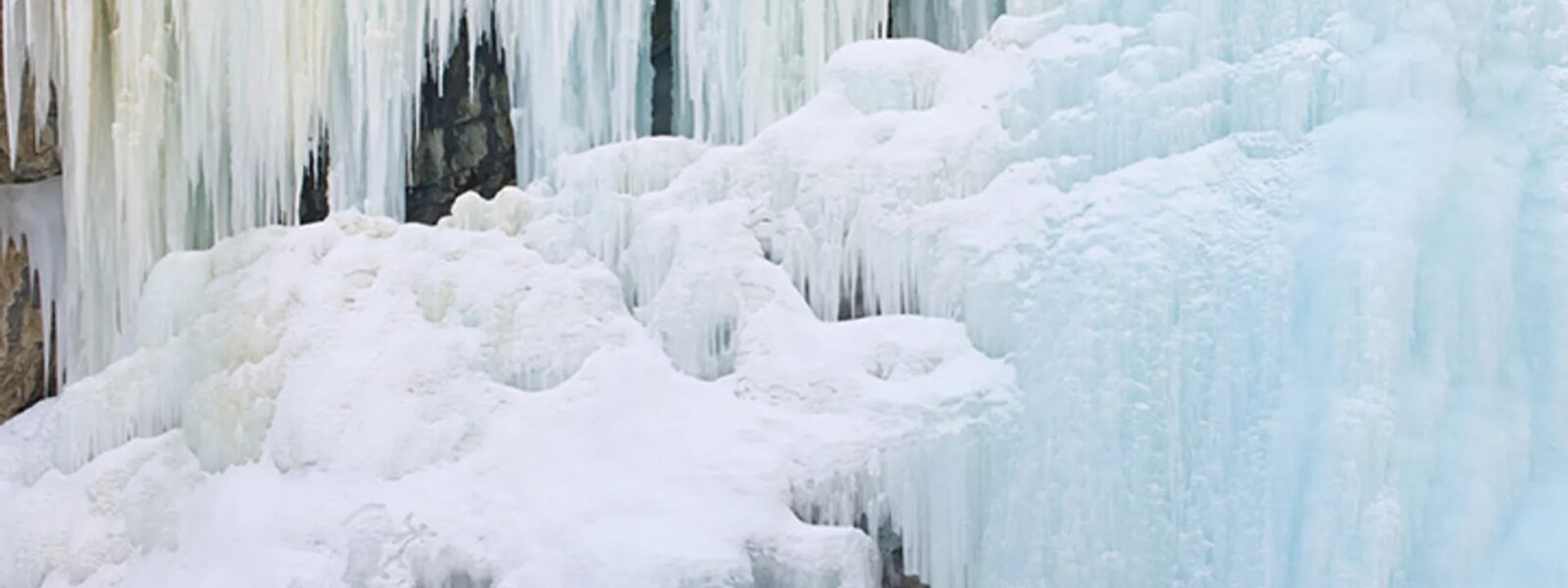Where Silence Becomes the Road: Reflections from the Frozen Zanskar
By Elena Marlowe
I. Listening to the Frozen Pulse
The first encounter with stillness
The plane skims low over a valley that seems wider than memory, and then Leh appears—small, bright, improbably calm in the heart of winter. The door opens and the air finds you first: thin, crystalline, carrying the taste of sunlight on snow. Before any itinerary begins, before boots meet ice, the Chadar Trek Ladakh begins here, in the gentle discipline of breathing. Acclimatization is less a checklist than a re-tuning. You learn to measure your steps by the rhythm of your lungs, to drink water as though it were a pact with altitude, to welcome slowness as a teacher. Outside, white ridgelines collect morning light like quiet hymns. Inside, the kettle purls, releasing steam that smells faintly of cedar and cardamom. There is nothing to chase. The mountains are not a race to be won; they are a conversation to be entered with care.
Shanti Stupa waits above town, a bright bowl of silence that gathers the first rays and pours them back across the cold roofs and prayer flags. The climb is modest, the lesson enduring: every pause is an attention paid to the body; every breath is an agreement with the height that holds you. You will be walking on silence soon enough. For now, the work is to let the noise of other lives fall away. A sparrow lands on the railing and looks at you with the steady curiosity of things that endure the season each year. Locals pass, wrapped in wool, greeting with a nod that says: winter is not an obstacle but a form of time. You feel it then—the river below the ridges, asleep beneath its sheets of blue glass, keeping its own counsel. The frozen Zanskar is not waiting for you; it is simply being itself. When you finally lie down that first night, the heater whispers and the city quiets, and you realize the journey’s opening chapter has already been written in breath and snowlight.
The acclimatization of attention
What altitude changes first is not the body but the attention. The world grows precise: the grain of frost on a windowpane, the high bark of a dog down on Old Road, the smoke drawing a clean line from a chimney into the stillness. The Chadar Trek Ladakh calls for a form of looking that conserves energy, yes, but also honors detail. You walk slower and see more. You drink more and think less. The mind, so used to sprinting, learns the pace of mountains. Each instruction from your guide—hydrate, rest, avoid exertion—feels at first like a delay and then like an initiation. In the tourist office, permits are stamped with a thud that sounds like consent; at the hospital, the medical check is not bureaucratic but benevolent, a reassurance that you arrive ready to listen.
By afternoon, the light turns brass and even the shadows have edges. You eat simply; a soup that tastes of warmth and patience, bread that gives way with steam. The river is hours away, but you begin to understand it in the choreography of the day: deliberate, measured, spare. A winter city teaches you how to be a good guest long before you reach the ice. The night is bright with stars—crowded, almost metropolitan in their numbers—and you stand a minute longer on the terrace, letting their cold fire settle behind the eyes. Tomorrow will carry you toward the mouth of the gorge; tonight is for learning to inhabit your breath. The trail ahead is a sentence the river has written; you are practicing the alphabet it requires.
II. The River That Sleeps
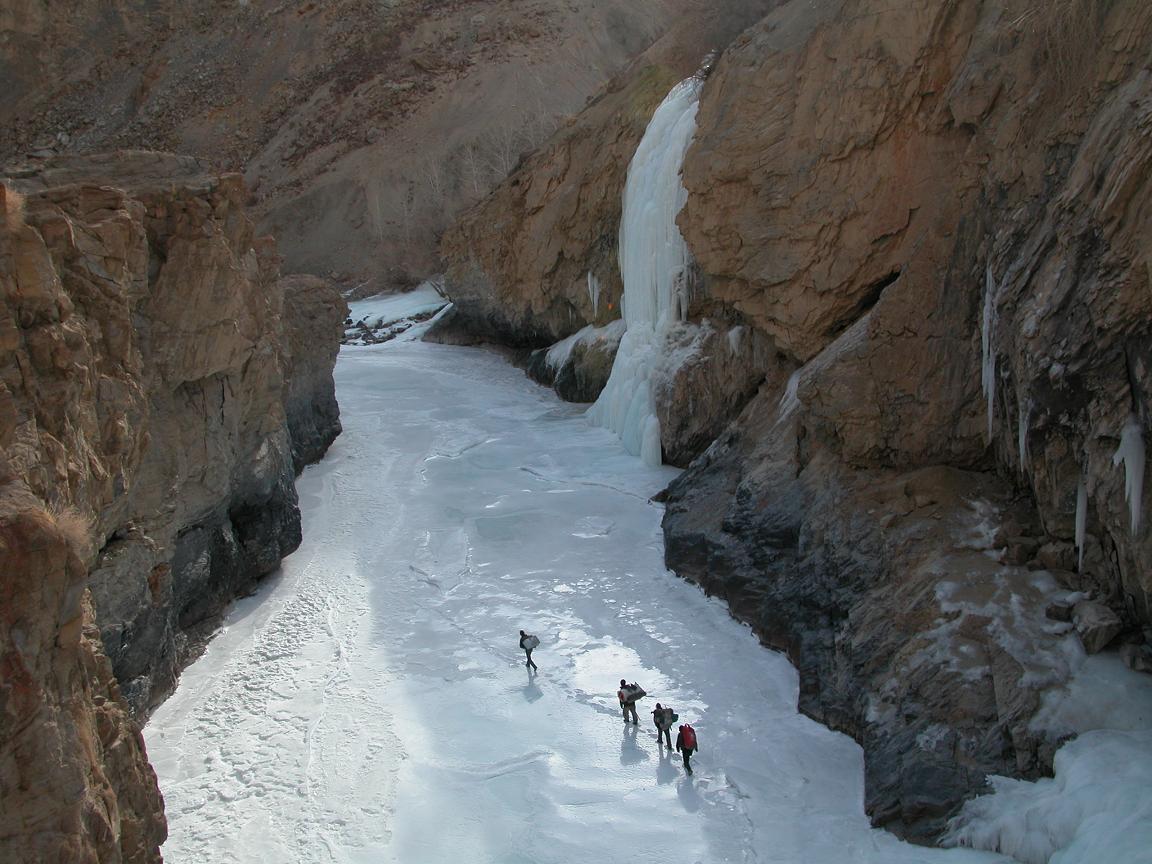
Geography turning into emotion
The drive to Shingra Koma is a catechism of turns: along cliffs ribbed with ice, through valleys where wind combs the snow into pale dunes, past stupas that hold their own weather of prayer. The Zanskar appears not as a line but as a field—blue-white, glazed, opaque in places and glass-clear in others where pebbles show like constellations held just beneath the skin. The first step onto the Chadar is less heroic than intimate, like stepping into a story already underway. This is where the Chadar Trek Ladakh reveals its grammar: weight distributed evenly, poles testing the sentence ahead, eyes scanning for scuffed powder that means traction, for dull white that means trust, for dark green that means water thinking of waking. The river does not speak, yet it phrases silence in clauses of frost and emphasis of crackle.
Walking here converts geography to emotion. The gorge narrows and suddenly the sky is a ribbon. Sound behaves differently—your breath becomes the metronome, and the small skid of a boot the percussion that marks each cautious stride. Ice carries memory; you can read last week’s thaw in a glazed bulge, last night’s breathless cold in the brittle starbursts radiating from a fracture. The mind, usually noisy with plans, falls quiet in the presence of such intent stillness. You are not conquering a route; you are consenting to a relation. The mountains do not perform, and yet the theater of light and wind is relentless, generous, exacting. Someone laughs ahead—high, bright, a moment of warmth that skims along the canyon walls and disappears into blue. You feel it: the river’s patience schooling your own.
The ethic of slowness
Progress on the Chadar is measured less in kilometers than in agreements kept: with cold, with caution, with your companions. Guides tap the ice with a steel point and knowledge older than maps. They read ripples like paragraphs and ledges like footnotes: here the ice is young and loud; there it is ancient and quiet. The ethic that emerges—unwritten yet inviolable—is slowness. Not the lag of fatigue, but the choice to make each step deliberate enough to deserve the next. This is the heart of the Chadar Trek Ladakh: an apprenticeship in restraint. Hurry here is not only rude; it is unsafe. Slowness spreads through the group like a benevolent contour, and with it comes a broader field of notice. You see lichen the color of old gold, a feather trapped in hoarfrost, the ash-gray script of last summer’s runoff on a granite wall.
By midday, warmth rises from the tea poured into tin cups, and conversation takes on the texture of the place—spare, precise, edged with laughter that fogs the air. A raven turns once in the wedge of sky and angles away. The river mutters beneath, a sound like pages turned in a distant library. You realize how tenderness and caution rhyme here: the way a hand reaches to steady a stranger, the way a boot heel is placed not only for self but for the one behind. The trail is a shared sentence, its subjects plural. Slowness makes room for care, and care makes room for beauty that haste would have blurred.
III. Footsteps on Glass
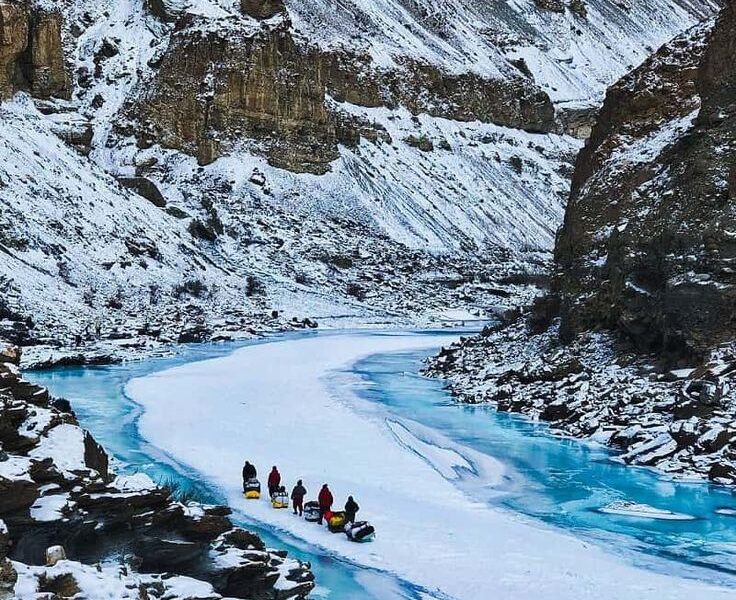
The choreography of trust
There is a science to walking on ice and an art to staying with yourself while you do it. Knees unlocked, hips soft, weight low and centered as if you were negotiating with the earth for a truce. The microspikes bite when they must and glide when they can. Poles place, test, and lead the way with a tact learned one stripe of ice at a time. Underfoot the river is a gallery of textures: snow that squeaks like chalk, glass that shows your reflection in fractured panoramas, braided seams where two cold spells met and stitched themselves together. The Chadar Trek Ladakh teaches that trust is always particular; you trust the square foot you have listened to, felt, tested. Anything larger is romance. And yet romance arrives anyway—in the light that runs like quicksilver across a slick, in the sudden cathedrals of ice where winter has draped the canyon walls with translucent organs that sing in the wind.
Silence is not absence; it is a presence with edges, a body the day moves around. You begin to hear its modulations: the low groan of pressure relenting; the shy tinkle where a thin sheet slips and settles; the deep, almost mammalian sigh that rises from seams far below. Each sound is a punctuation mark you learn to read: pause here; wait there; give the river a moment to finish a sentence you cannot see. The body, so often commanded by schedules, becomes conversant with cues less legible than clocks yet more binding. In this way, the gorge is a school where the curriculum is one thing repeated in infinite form: attention. You move like a careful verb through a long sentence of ice, revising as you go, finding a syntax of breath and balance that feels, at last, like belonging.
The mirror that does not flatter
A frozen river is the plainest mirror. It reflects not your best angle but your current truth: are you hydrated, present, warm enough, honest about your limits? The Chadar Trek Ladakh makes little room for posturing because the ice is immune to performance. It cares only for pressure, temperature, texture, angle. You learn to eat when not hungry because the body is a ledger; to rest when not tired because fatigue compounds with ruthless interest; to speak up when a boot strap loosens or a glove dampens because small discomforts recruit larger ones. In exchange, the place grants the gift that cities withhold: the felt sense of being a single human among immensities, not reduced, not exalted, simply proportioned.
There are moments when beauty arrives at an unsustainable pitch: a shaft of light catching trapped bubbles so that they glow like fossilized constellations; a gust setting snow-devils dancing in a bright corridor; the sudden intimacy of a sand grain visible under a millimeter of glass. You feel both elation and a light sorrow, knowing that the river you walk today will not be the river you return on. The ice is a daily composition, revised each night by cold and breath. You learn, reluctantly and then gratefully, that transience is not a loss but the very mechanism by which meaning becomes visible. The mirror does not flatter; it clarifies. And in that clarity you find not vanity, but a patient form of courage that travels well beyond the gorge.
IV. The Cave of Fire and Breath
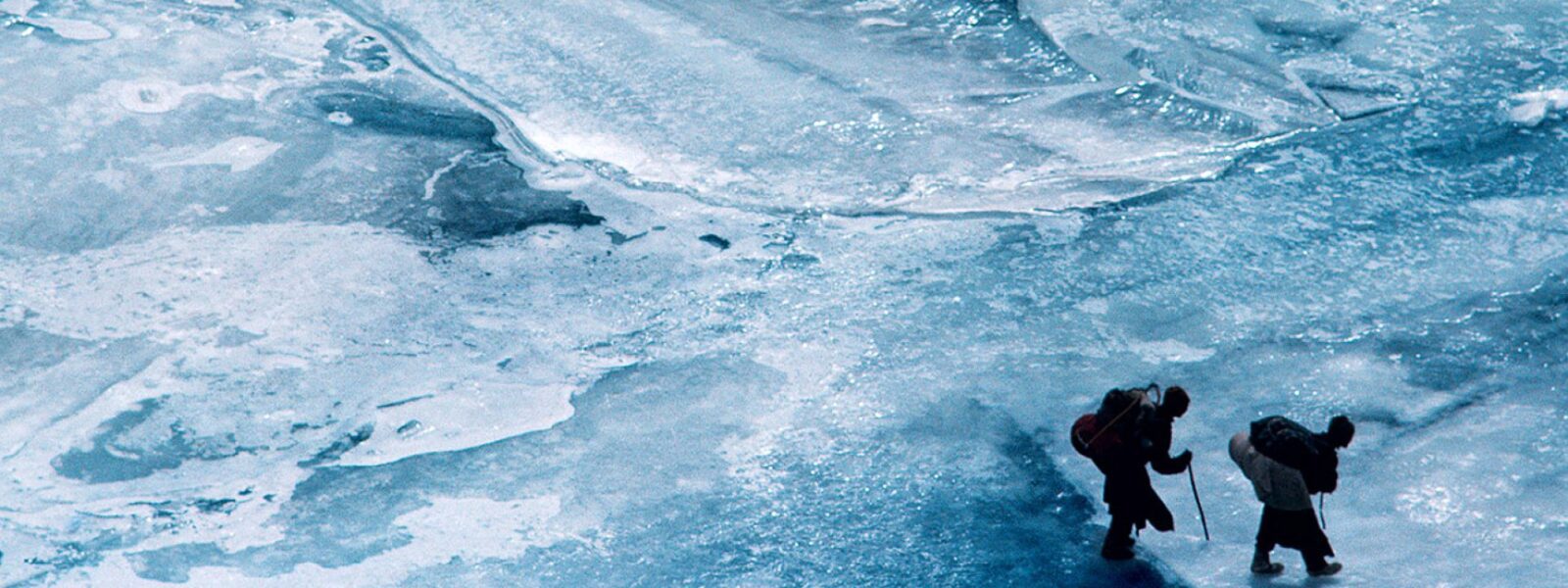
Company inside the cold
By late afternoon the canyon’s blue deepens and the wind lengthens its vowels. You arrive at Tibb, not a village but a verb: to shelter, to gather, to turn a handful of fire into a circle of faces. Tibb Cave raises its stone lip against the wind, and within that cup of shadow a small civilization appears—stoves, steam, jokes reborn from yesterday, gloves drying by the doorway, the neat economy of tasks done with numb fingers and goodwill. The Chadar Trek Ladakh is famous for its landscapes, but it is this human wintering that endures: the way strangers, lit from below by a small fire, begin to speak not of achievement but of gratitude. You learn the names of places and the nicknames of people and the way the guide’s voice changes when telling a story that is a lesson disguised as laughter.
Tea tastes like courage; soup tastes like luck. Someone shares about the first time the river spoke sharply underfoot and the exact shape of the fear that climbed their spine and left again. A kettle whistles and is quieted. The cave’s mouth frames a darkening corridor of ice where the last purples of light tuck themselves away. You feel the day settling into its second life—the communal one—where tasks are done for the group not because rules say so but because the work braided your rhythms together without asking permission. This is winter’s hospitality: not abundance but sufficiency, not flamboyance but care made visible in the right place at the right time. The warmth does not make the cold vanish; it teaches you how to befriend it.
Firelight and the grammar of stories
Around the stove, stories seek their own gravity. A porter remembers his grandfather’s winter crossings when the Chadar was courier and classroom. A traveler confesses she came to prove something and is leaving with something easier and harder: a respect for limits that feels like an opening rather than a fence. You realize how the grammar of these narratives mirrors the canyon—long clauses that pause for breath, simple sentences offered like bread. In this circle, the Chadar Trek Ladakh is not an itinerary but an inheritance carried across tongues. Outside, the wind scours the ice with a sound like chalk on slate. Inside, someone mentions the snow leopard as a rumor with whiskers; everyone smiles into the steam.
What endures here is not our passage, but our attention. The river forgets our names and remembers our care.
Later, the stars arrive in irresponsible numbers, and the cave holds the shape of warmth as carefully as a memory holds light. Sleep comes tight in the bag, a hibernation learned from bears you will not see. In dreams the river is both road and voice, and you wake unsure which you were following. Morning will make its simple demands—boots, straps, tea, step—and you will meet them with the uncomplicated dignity that firelight taught.
V. When the Waterfall Turns to Stone
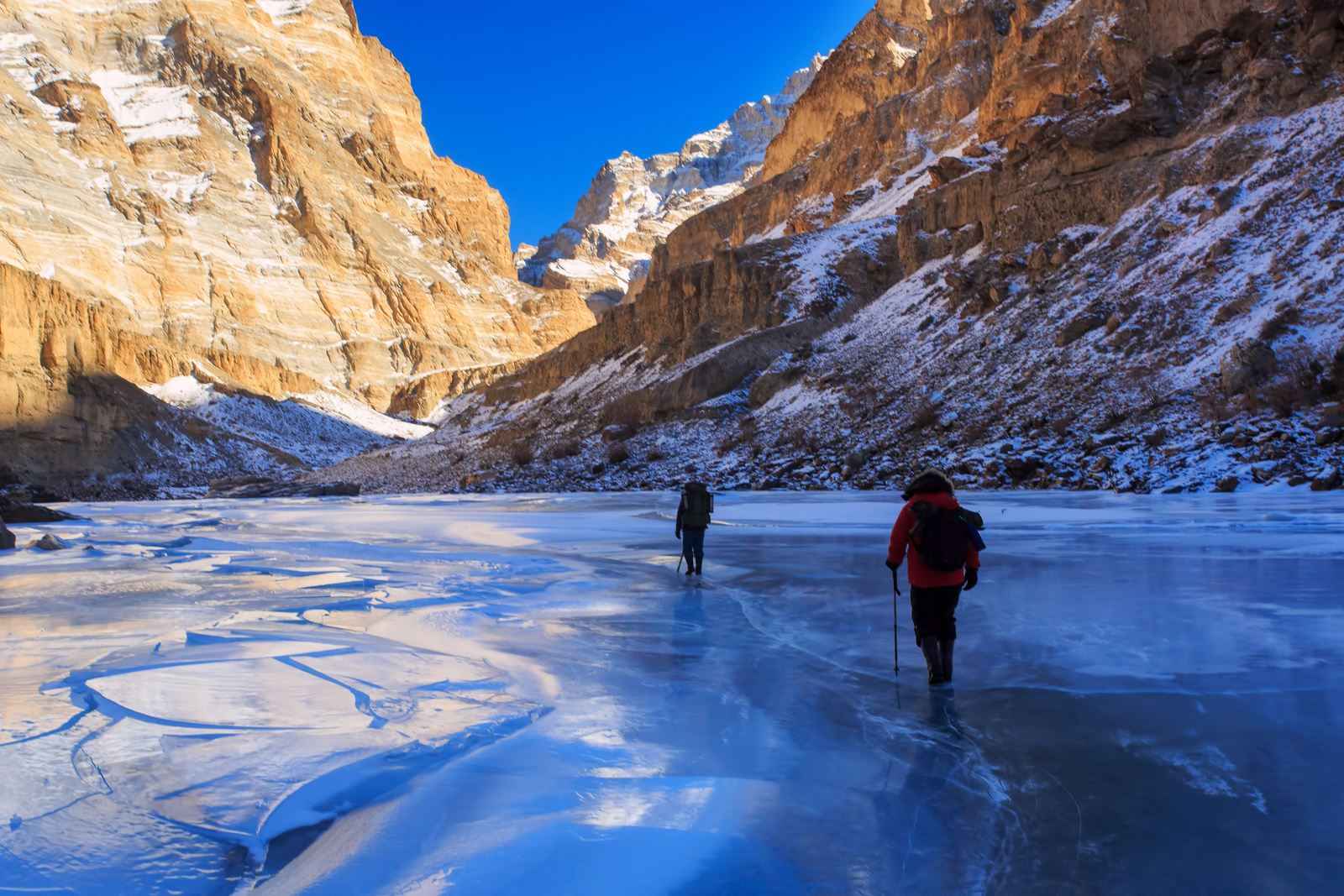
Nerak: beauty caught between motion and stillness
The gorge opens by degrees, then tightens again, like a book skipping ahead and returning to a favorite chapter. Nerak announces itself first as rumor—a cold in the air with a sharper edge—then as spectacle: a waterfall paused mid-sentence, its commas and clauses made of ice. The cascade’s surfaces run from glass-clear to milk-white to glacial blue, as if the place were a catalog of the way water can exist. The Chadar Trek Ladakh carries many headlines, but this one still manages to feel like a secret. You stand there a long time, watching light perform its alchemy across those curtains and pillars, turning time into architecture. Prayer flags nearby offer their bright grammar to the wind, a reminder that motion persists even where it appears arrested.
What do we learn when movement is made visible by its suspension? That flow is not only a verb but a form; that the patience of winter is not punitive but instructive; that beauty, when held too tightly, fractures. Nerak’s village waits close by, quiet with the business of staying warm and well. In the single-room kitchens, butter tea answers questions you didn’t know you were asking. You are welcomed not with ceremony but with the uncomplicated yes of people who have no theatrical relationship to weather. Here, endurance wears a human face. A boy in a maroon sweater leads you to where the view is fractionally better; a woman adjusts a shawl and asks where you are from in a cadence that folds the world in two. You answer with the clumsy generosity of a guest, knowing that hospitality is not a transaction but a brief, shared grammar of care.
The bridge that sleeps and the stories that cross anyway
In summer a bridge near Nerak braids two banks into a single sentence; in winter it sleeps under drifts and memory. The crossing still happens—the river itself becomes the road and the old economy of footfalls takes over. You think about infrastructure as a promise that weather keeps editing. The Chadar Trek Ladakh survives because communities improvise: rerouting around thin ice, anchoring lines where the shore allows, reading the day’s temperature not only in a device but in the timbre of wind in a side canyon. Your own steps feel less like personal achievement and more like participation in a long continuity of motion chosen wisely.
By the time the sun lowers, the waterfall has turned again from blue to pewter, and shadows build the day’s final architecture. Camp rises in the old choreography—tents, stoves, laughter—and the gorge’s acoustics make a small community sound like a town. You stare a long time at the cascade in the gloaming, and silently concede that stillness can be a kind of eloquence. Later, tucked into your sleeping bag, you feel the day as a collage of textures: the grain of rope against glove, the slick resistance of a glassed stretch, the wool’s kindness against skin. Memory begins its patient work of making sense. It will take all winter and perhaps longer.
VI. Returning on the Same River, Differently
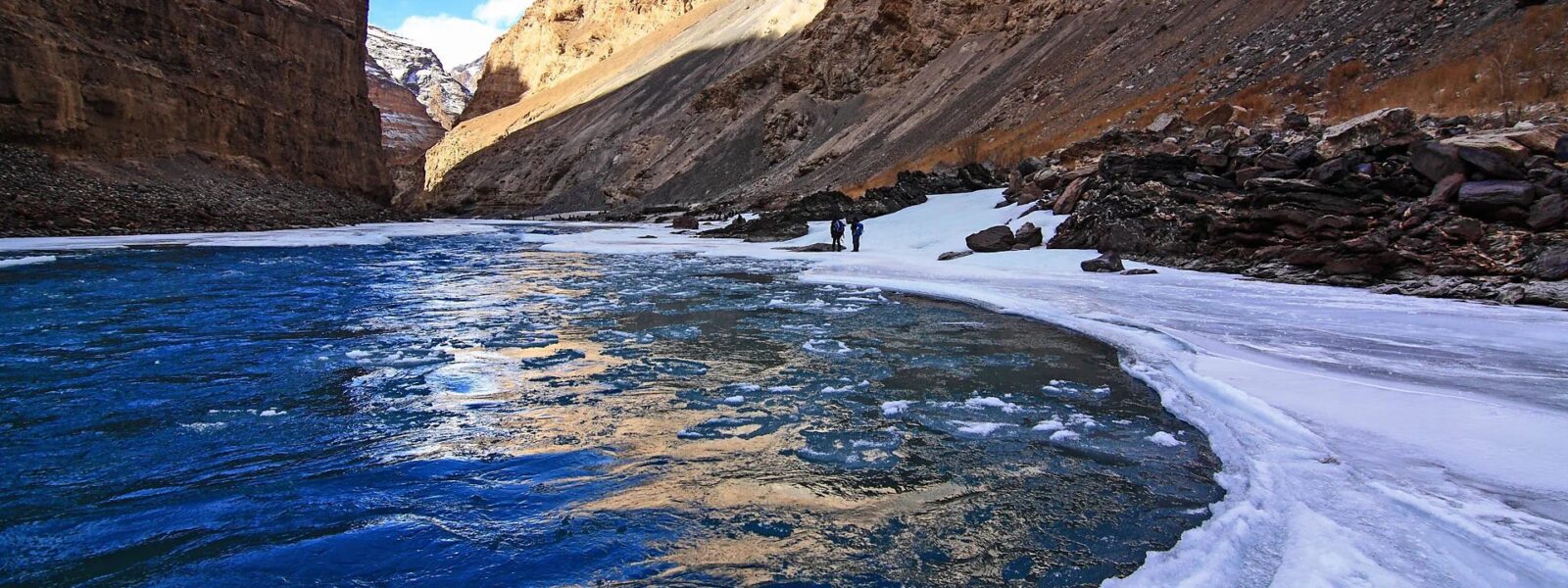
The pedagogy of repetition
On the return the Chadar is new. Night has revised the draft: yesterday’s surety now ringed with frost feathers; yesterday’s caution thickened to a trustworthy dullness. You find old boot prints softened by spindrift and lay your own over them, a palimpsest of assent. The canyon, like any good text, yields more on the second reading. You recognize the corner where light turned brass and anticipate the bend where the wind greets you head-on. Repetition works on the mind the way cold works on water—gathering, clarifying, setting form. The Chadar Trek Ladakh becomes less spectacle and more sentence; you learn to conjugate its verbs: to wait, to weigh, to warm, to watch.
The companionship changes, too. Strangers have become a pronoun that needs no explanation. You know by now who will tap the ice with a dancer’s grace, who will tell the joke at precisely the right place in the climb, who will share a last biscuit without theater. The canyon mirrors this camaraderie by offering small mercies—an easier angle around a bulge, a snow-berm that cushions the foot, a lee that allows the tea break to be laughter rather than endurance. You realize that awe is renewable but not inexhaustible; it needs the compost of routine. The second passage gives awe its context. You are not an explorer anymore; you are a guest returning a borrowed book.
What melts is what stays
Philosophy sneaks up on you in practical clothes. You catch yourself thinking that perhaps the most durable experiences are the ones that refuse to be fixed. The ice you loved will fracture and run to river; the neat seams will dissolve into a moving braid; your careful footnotes on the day’s textures will blur into weather. And yet the Chadar Trek Ladakh is not diminished by its endings; it is defined by them. The lesson is not to capture, but to attend. Attention, faithfully paid, survives the thaw. You will carry the echo of the gorge into places that have never seen snow: the way a hallway grows quiet at night; the minuscule theater of light on a glass of water; the instinct to wait a beat before speaking, in case the ice has something to say.
By the time Tibb Cave gathers you again, firelight feels like a friend you met decades ago. The stories told now have a different gravity, less about achievement, more about nuance—the exact tone of wind before it turned, the not-quite-color of the ice where it was oldest, the way the guide’s silence at a certain bend felt like a bell. You sleep as if winter itself were tucking you in, and in the morning your pack finds your shoulders as if it learned their shape. The return is not a reversal; it is the river teaching the second half of its lesson.
VII. After the Ice
Leh again, and the measure of change
Evening has a way of returning you to yourself. Leh’s lanes accept you without ceremony, the hotel heater issuing its domestic hum as if the mountain’s own breath had moved indoors. The Chadar Trek Ladakh is behind you and also inside you. Warm water finds cold hands, and the body notes each ordinary luxury with a gratitude so quiet it could be mistaken for prayer. You walk to the rooftop for one more look at the hills turning purple, and notice how some interior weather has shifted—the part of you that hurried now listens; the part that demanded is content to ask. The river has given back the simplest riches: appetite, sleep, unembarrassed attention. You will pack and fly and work and write; the ice will melt and run and fall and rise. Between you there remains a compact, renewed with each winter: to meet the world at the pace where it can be seen.
In conversation later with a driver, you ask about the season, about the times when the Chadar runs late or comes early, and he shrugs in the elegant grammar of those who live with weather: it changes, we change with it. There is no heroism in the statement, only a clarity that feels like light. You think of the waterfall at Nerak, the way beauty held its breath long enough for you to learn its shape. You think of Tibb, of fire bending stories toward one another. You think of a single step taken slowly enough to belong to the ice that received it. The world is not new; your attention is. That is enough.
FAQ — Practical questions answered from experience
Is the Chadar Trek suitable for first-time high-altitude travelers?
The Chadar Trek Ladakh is a winter, high-altitude journey that rewards preparation and humility. First-timers can succeed if they respect the two pillars of safety: acclimatization and honest pacing. Spend at least two full days in Leh to let your body recalibrate, drink more water than your habits suggest, and keep early movements easy and unhurried. Choose an operator that emphasizes small groups, qualified guides, and daily health checks. Remember that the ice is not a stage for bravado; it is a teacher of slowness. If you can commit to listening—to your body, to your guide, to the ice—then even a first encounter with altitude can become a steady, meaningful initiation rather than a trial.
What gear is absolutely essential in deep winter conditions?
Treat your kit as a covenant with cold. The essentials for the Chadar Trek Ladakh are less about brand and more about layering logic: a moisture-wicking base to keep skin dry, an insulating mid-layer that traps warmth without bulk, and a windproof outer layer that blocks gusts in the gorge. Pair these with insulated boots compatible with microspikes or crampons, waterproof gloves plus a warm liner, and a hat that covers the ears without slipping. A headlamp, thermos, and sunglasses with high UV protection sound obvious until the day you need them badly. Finally, honor your feet: dry socks, blister care, and the discipline to change out of damp layers before chill sets in. Comfort here is not luxury; it is risk management turned intimate.
How dangerous are cracks and thin ice really?
Cracks are the river speaking. Some are superficial—frozen signatures of yesterday’s stress—while others signal water in motion beneath. On the Chadar Trek Ladakh, guides read these signs the way farmers read sky. You will learn to trust that literacy. Darker, greener patches may point to thinner ice; glossy, glass-clear surfaces can be strong but slick; snow-dusted dull white often affords traction. The ethic is simple: test before trust, step where the guide steps, and accept detours as wisdom, not delay. On some days you will thread the shoreline, weaving through boulders and frozen eddies. Safety here is communal—vigilance shared is risk reduced. The river does not reward cleverness; it rewards attention disciplined by experience.
What’s the best time window, and how variable are conditions?
Mid-winter is the season of possibility, with late December through February often offering the most consistent ice. Yet the Chadar Trek Ladakh lives at the mercy of temperature swings and snow events that can transform a section overnight. One week the path reads like polished marble; the next, it’s a quilt of crust, powder, and glass. Build flexibility into your expectations and your itinerary. Accept that conditions are not inconvenient facts but the very texture of the journey. The beauty of the Chadar lies in its revisions; a path too predictable would not be this river at all.
How do I respect local communities and the environment?
Begin with the quietest practices: pack out everything, including micro-trash; tread where the trail has been established; minimize noise in camps where sound ricochets off stone. The Chadar Trek Ladakh threads through lives for whom the river is not a sport but a corridor of necessity. Buy locally where possible, ask before photographing, and match curiosity with courtesy. Winter amplifies both beauty and impact. Leave the gorge as if your footprints were written in light. The ice will remember our care longer than it remembers our names.
Conclusion — What the river keeps
The frozen Zanskar is not a trophy but a conversation. It teaches by repeating itself differently each day, by asserting that attention is a more reliable compass than ambition, by revealing how patience and caution can be forms of love. Along its length, the Chadar Trek Ladakh asks the same question in a hundred dialects of cold: will you move at the speed of understanding? When you do, the place opens—not in revelation but in permission. You are allowed to see what is there: air drawn thin as silk, ice stippled with stars, companions whose steps fit the same sentence. In leaving you carry a new appetite for quiet, a revised belief about what the body can learn, and a sense that the world offers more when met with less.
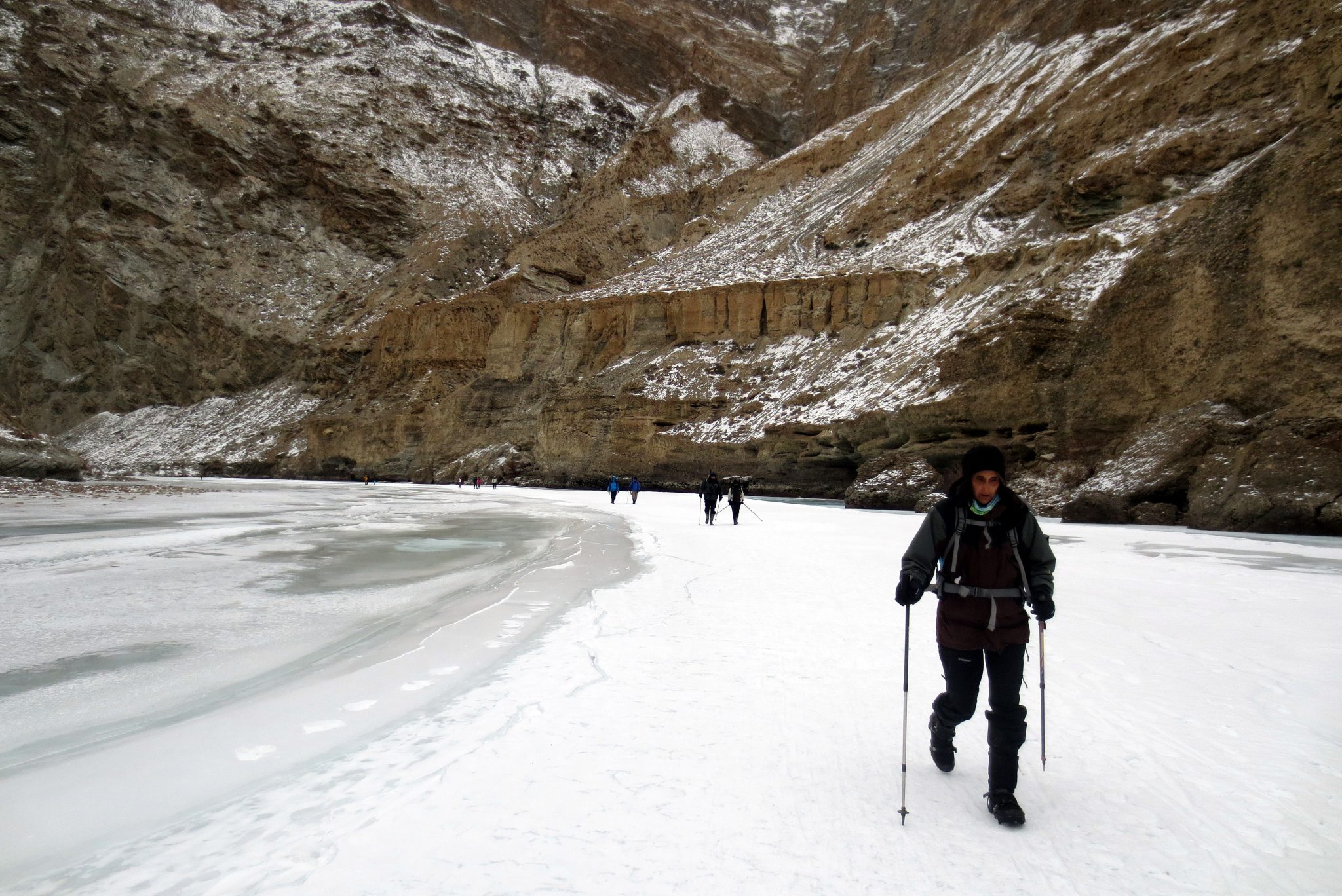
Closing note — An invitation to winter’s grammar
Take with you the practice the river taught: to pause, to look again, to step where care has been placed before. Let that practice travel into rooms with heating vents and meeting agendas, into cities where your breath no longer fogs the morning. The Chadar Trek Ladakh will thaw and run, and you will call that change spring; yet what matters was never the permanence of ice but the clarity it lent the heart. When you find yourself hurrying toward something you do not need, remember a single boot’s quiet, deliberate landing on blue glass, and the way the world—just for a moment—held perfectly still.
About the Author
By Elena Marlowe
Elena Marlowe is the narrative voice behind Life on the Planet Ladakh, a storytelling collective exploring the silence, culture, and resilience of Himalayan life. Her work reflects a dialogue between inner landscapes and the high-altitude world of Ladakh, balancing elegant observation with practical insight. She writes for European readers who seek journeys that change the pace of the mind as much as the map.

